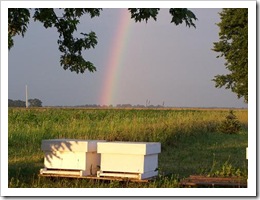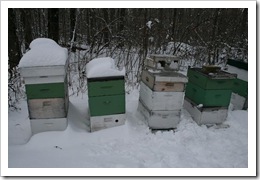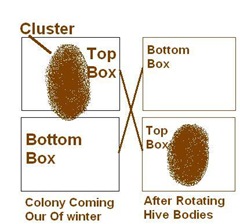Lesson 25: Queen Excluders? Pros & Cons
Hello everyone, from Long Lane Honey Bee Farm in Central Illinois! Today, I want to share some thoughts on QUEEN EXCLUDERS, but before I do, take a look at these pictures.
 A few summers ago, I took this beautiful picture after a brief rain. We became known on Ebay with this picture! Someone even suggested we should make this picture into a poster and sell it. During the winter, this picture gives us all hope of spring rains, flowers, bees, nectar and rainbows! I can't wait.
A few summers ago, I took this beautiful picture after a brief rain. We became known on Ebay with this picture! Someone even suggested we should make this picture into a poster and sell it. During the winter, this picture gives us all hope of spring rains, flowers, bees, nectar and rainbows! I can't wait. 
But back to reality, it's February and here's what my hives looked like on the first day of February. I believe in removing the snow off the top of the hives ASAP, because on a warm day, the melting snow can drip and run into the hive in places that rain would not. In the picture above you can see the difference between the two hives with snow on the left, and the hives on the right that have been cleared of snow.
 I also clear out the bottom board occasionally. It's so much work for the bees to do, that I feel like I can help them out some. Plus, to me, it seems the less dead bees in the hive, the healthier it is. The picture above, taken Feb. 1, 2008, shows dead bees that I have raked off the bottom board with a stick. This is a normal amount of dead bees during the winter.
I also clear out the bottom board occasionally. It's so much work for the bees to do, that I feel like I can help them out some. Plus, to me, it seems the less dead bees in the hive, the healthier it is. The picture above, taken Feb. 1, 2008, shows dead bees that I have raked off the bottom board with a stick. This is a normal amount of dead bees during the winter.
LESSON 24: QUEEN EXCLUDERS: Pros & Cons
What is a queen excluder. A queen excluder is a metal or plastic material that looks somewhat like a grill which is sized so that worker bees can pass through, but the queen and most drones are too big and therefore are excluded from passing through. Thus the name Queen Excluder.
When & Why To Use A Queen Excluder
The most common use of a queen excluder is to place it directly above your top brood box. Then, all honey supers are placed above the excluder. The excluder then is able to keep the queen in the brood chambers and excludes her from getting into the honey super and laying eggs. Excluders are also used in hives where the beekeeper is operating a two queen hive.
I generally do not use queen excluders on my hives for several reasons. 1) To me, they are high maintenance. The bees often attach comb to the excluder thus reducing the passageway, 2) Drones can become stuck and reduce the passageway, 3) I want my bees to be able to easily go in and out of the honey super, so I fear that the excluder discourages the bees from filling a super if they have to work their way through an excluder.
I am often asked whether a new beekeeper should use a queen excluder. For the most part, I would say yes. However, when that same new beekeeper calls me up and tells me his bees are not going up into the top super, I would recommend removing the excluder. This is why I am reluctant to recommend queen excluders. Some beekeepers call them honey excluders.
You're probably wanting to know what I do to keep the queen out of my supers if I do not use queen excluders, right?
I monitor the location of my queens. This is why, in early spring, I rotate my two deep hive bodies. I want to work the queen down to the bottom of the hive as she typically will work her way up. Coming out of winter the bottom deep brood hive body is usually empty, and so by placing the queen below 10 frames of empty drawn comb, she can begin laying with plenty of room and this will slow her movement to the upper honey super. So, an experience beekeeper can keep an eye on the queen and move her back down as he see fit. Here's an illustration I drew up to help you see how to rotate your hive bodies in the spring.
So, an experience beekeeper can keep an eye on the queen and move her back down as he see fit. Here's an illustration I drew up to help you see how to rotate your hive bodies in the spring.
On the other hand, a new beekeeper may not want to monitor and reposition the queen, or rotate the hive bodies so in this case, a queen excluder is a good practice.
If you'd like to purchase a queen excluder, you can do so by clicking here to go to our website: honeybeesonline.com or give us a call at 217-427-2678
We are still selling 3 lb packages of bees with an Italian queens (pick up only or we will ship upon the purchase of a hive) and we are also offering nucs but on a first come first serve basis. And if you have not purchased your beekeeping hives or equipment, we are here to take your order Mon. - Fri. 9am - 5pm at 217-427-2678
If you'd like to email us our address is david@honeybeesonline.com
And check out our website for great deals: www.honeybeesonline.com
Our next lesson will address trying to lure hives from structures or trees. Do swarm lures work?
See you next time, and remember,
Bee-Have Yourself!
David & Sheri Burns
Long Lane Honey Bee Farms
217-427-2678
www.honeybeesonline.com

But back to reality, it's February and here's what my hives looked like on the first day of February. I believe in removing the snow off the top of the hives ASAP, because on a warm day, the melting snow can drip and run into the hive in places that rain would not. In the picture above you can see the difference between the two hives with snow on the left, and the hives on the right that have been cleared of snow.
LESSON 24: QUEEN EXCLUDERS: Pros & Cons
What is a queen excluder. A queen excluder is a metal or plastic material that looks somewhat like a grill which is sized so that worker bees can pass through, but the queen and most drones are too big and therefore are excluded from passing through. Thus the name Queen Excluder.
When & Why To Use A Queen Excluder
The most common use of a queen excluder is to place it directly above your top brood box. Then, all honey supers are placed above the excluder. The excluder then is able to keep the queen in the brood chambers and excludes her from getting into the honey super and laying eggs. Excluders are also used in hives where the beekeeper is operating a two queen hive.
I generally do not use queen excluders on my hives for several reasons. 1) To me, they are high maintenance. The bees often attach comb to the excluder thus reducing the passageway, 2) Drones can become stuck and reduce the passageway, 3) I want my bees to be able to easily go in and out of the honey super, so I fear that the excluder discourages the bees from filling a super if they have to work their way through an excluder.
I am often asked whether a new beekeeper should use a queen excluder. For the most part, I would say yes. However, when that same new beekeeper calls me up and tells me his bees are not going up into the top super, I would recommend removing the excluder. This is why I am reluctant to recommend queen excluders. Some beekeepers call them honey excluders.
You're probably wanting to know what I do to keep the queen out of my supers if I do not use queen excluders, right?
I monitor the location of my queens. This is why, in early spring, I rotate my two deep hive bodies. I want to work the queen down to the bottom of the hive as she typically will work her way up. Coming out of winter the bottom deep brood hive body is usually empty, and so by placing the queen below 10 frames of empty drawn comb, she can begin laying with plenty of room and this will slow her movement to the upper honey super.
On the other hand, a new beekeeper may not want to monitor and reposition the queen, or rotate the hive bodies so in this case, a queen excluder is a good practice.
If you'd like to purchase a queen excluder, you can do so by clicking here to go to our website: honeybeesonline.com or give us a call at 217-427-2678
We are still selling 3 lb packages of bees with an Italian queens (pick up only or we will ship upon the purchase of a hive) and we are also offering nucs but on a first come first serve basis. And if you have not purchased your beekeeping hives or equipment, we are here to take your order Mon. - Fri. 9am - 5pm at 217-427-2678
If you'd like to email us our address is david@honeybeesonline.com
And check out our website for great deals: www.honeybeesonline.com
Our next lesson will address trying to lure hives from structures or trees. Do swarm lures work?
See you next time, and remember,
Bee-Have Yourself!
David & Sheri Burns
Long Lane Honey Bee Farms
217-427-2678
www.honeybeesonline.com











0 comments:
welcome to my blog. please write some comment about this article ^_^